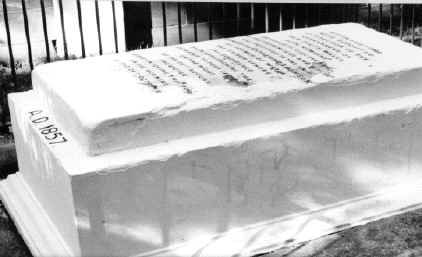Sole survivor of great peacetime tragedy
It is a sad and tragic state of affairs when one person is lost to us. But when a large number of people die in a tragic event or circumstances, the loss can be unbearable for a greater number of mourners. This was the case when the clipper Dunbar was smashed against the reef at the foot of South Head at the entrance to Sydney Harbour, in 1857.
Captain Green and his crew had two options on the night of Thursday, 20 August, 1857. Dangerous weather conditions had given them a choice of waiting until morning to enter Sydney Harbour via the heads or take their chances. They chose the latter.

Grave and memorial for Dunbar victims in Camperdown Cemetery. Photo: NSW State Archives & Records.
The ship broke up immediately as it collided with the dangerous reef and in the hours that followed 121 passengers - men, women and children - and crew were drowned in one of Australia's worst maritime peacetime disasters. The only survivor was an Irish crew member by the name of James Johnson, who clung to a ledge on the cliff face until he was rescued two days later.
A steamer left Circular Quay on the morning of 22 August, 1857 with the Inspector General of Police and the Coroner on board to collect the bodies of the deceased passengers. Twelve bodies had washed up on Middle Harbour along with two cows and a horse.
After being rescued Mr Johnson gave an account of what happened that fateful night:
At the time of striking we were endeavouring to stretch out to the eastward. Her head was lying to the northward and she was drifting with the rise and fall of the sea....The ship was lying broadside on, in the heavy surf. The captain was standing upon the poop, cool and collected...There was great confusion when the word was given that the ship struck.
Johnson goes on to describe how the first bump saw the three topmasts go overboard. He had been standing on the poop deck and the first wave that crashed over them knocked him down. The ship, rather than passing safely through the heads, had smashed against the sheer cliffs south of South Head, near The Gap.

James Johnson, the sole survivor of the wreck of the Dunbar. Courtesy: Mitchell Library
"I immediately got up and took hold a rope. I then ran down into the cabin where I found one of the sky-lights...I got into the cabin and out of one of the skylights. I then got on the weather-side and crept into the mizen chains...Finding the vessel breaking aft, I moved forwards into the main chains and subsequently into the fore chains...I found myself upon four planks."
From there Mr Johnson was washed away from the ship. He eventually found a rock to cling to but could hear nothing but the rhythmic noise of the sea all around him. In the morning, after finding a place to huddle on the rock that saved him, he saw dead bodies floating in the sea. His only injury - a scratch on his knee.
The bodies of 22 people who perished were collected and placed in a mass grave at Camperdown Cemetery. A memorial still stands today in their memory.
Mr Johnson lived to his 78th year, dying in 1915. He was buried in Sandgate Cemetery, Newcastle next to his wife, who predeceased him by 25 years. He was survived by his four daughters.
References
'Wreck of the Dunbar', NSW Government State Archives & Records, accessed online 17th July, 2021, The Wreck of the Dunbar | NSW State Archives
'Wreck of the Dunbar', Empire, Saturday 22 August, 1857, Page 4
'Wreck of the Dunbar', Adelaide Times, Monday 7 September, 1857, Page 2
'Tragedy recalled - Survivor of the Dunbar', Daily Advertiser, Wednesday, 14 April 1915, Page 2
'Funeral of Mr James Johnson', The Catholic Press, Thursday 29 April, 1915, Page 23
'One of Sydney’s oldest cemeteries reveals the fascinating secrets buried in the city’s past', The Daily Telegraph, May 27, 2014, accessed online 17th July, 2021, One of Sydney’s oldest cemeteries reveals the fascinating secrets buried in the city’s past | Daily Telegraph
Comments